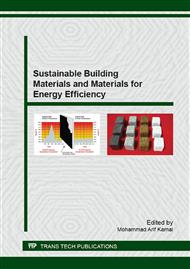[1]
C.L. Page and M.M. Page: Woodhead Publishing Ltd, Abington Hall, Abington, Cambridge C 6AHB21, England (2007).
Google Scholar
[2]
N. Cobirzan, A. Balog, C. Aciu and D. A. Ilutiu-Varvara: The 7th International Conference Interdisciplinarity in Engineering. Procedia Technology Vol. 12 (2014), p.542.
Google Scholar
[3]
M. C. Bignozzi. International Conference on Green Buildings and Sustainable Cities. Procedia Engineering Vol. 21 (2011), p.915.
Google Scholar
[4]
Y. Senhadji, G. Escadeillas, M. Mouli, H. Khelafi and S. Benosman: Powd. Technology, Vol. 254 (2014), p.314.
DOI: 10.1016/j.powtec.2014.01.046
Google Scholar
[5]
A.A. Ramezanianpour: Engineering properties and morphology of pozzolanic cement-concrete, PhD Thesis, University of Leeds, (1987).
Google Scholar
[6]
F. Massazza: Cem. & Concr. Composites Vol. 15 (1993), p.185.
Google Scholar
[7]
R.E. Rodriguez-Camacho: In the International Conference, Bangkok, Thailand, Vol. 178, (1998), p.1021.
Google Scholar
[8]
M. Ghrici, S. Kenai and M. Said-Mansour: Cem. Conc. Composite Vol. 29 (2007), p.542.
Google Scholar
[9]
N. Belas Belarbi, A. Semcha, and L. Laoufi: Can. J. Civ. Eng. Vol. 30 (2003), p.580.
Google Scholar
[10]
M. Mouli and H. Khelafi: Build. Environment Vol. 43 (2008), p.31.
Google Scholar
[11]
H. Siad: The Durability of Self-compacting concrete based pozzolanic additions and limestone fillers, PhD thesis, University of sciences and technology of Oran, Algeria, (2010).
Google Scholar
[12]
N. Kaid, M. Cyr, S. Julien, and H. Khelafi: Constr. Build. Mater. Vol. 23 (2009), p.3457.
Google Scholar
[13]
G. Fajardo, P. Valdez and J. Pacheco: Const. Build. Mater. Vol. 23 (2009), p.768.
Google Scholar
[14]
N. Kouloumbi, G. Batis and P. Pantazopulou: Cem. Concr. Aggregates, Vol. 17 (1995), p.18.
Google Scholar
[15]
A.K. Parande, B. Ramesh Babu, K. Pandi, M.S. Karthikeyan and N. Palaniswamy: Construction and Building Materials, Vol. 25 (2011), p.288.
DOI: 10.1016/j.conbuildmat.2010.06.027
Google Scholar
[16]
NA 442-03: Hydraulic Binders -Currents Cements, Composition, Specification and Criteria of Conformity, Algeria Standard, (2003).
Google Scholar
[17]
ASTM C 109-13: In American Society for Testing and Materials (ASTM) International, West Conshohocken, Pa, (2013).
Google Scholar
[18]
ASTM C 1202-12: In American Society for Testing and Materials (ASTM) International, West Conshohocken, Pa, (1997).
Google Scholar
[19]
ASTM C 876-09: In American Society for Testing and Materials (ASTM) International, West Conshohocken, Pa, (1999).
Google Scholar
[20]
T. Kulovaná, P. Rovnaníková, Z. Pavlík, R. Černý: Advanced Materials Research Vol. 982 (Trans Tech Publications, Switzerland 2014), p.22.
DOI: 10.4028/www.scientific.net/amr.982.22
Google Scholar
[21]
M.E. Natali, S. Manzi, L. Carabba, C. Chiavari, M.C. Bignozzi, M. Abbottoni, A. Balbo, C. Monticelli: Advances in Science and Technology Vol. 92 (Trans Tech Publications, Switzerland 2014), p.50.
DOI: 10.4028/www.scientific.net/ast.92.50
Google Scholar
[22]
A. Merida, F. Kharchi: Advanced Materials Research Vol. 911 (Trans Tech Publications, Switzerland 2014), p.494.
Google Scholar


